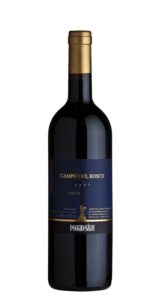Poggio Salvi: Every vintage, every terrain, every idea that you want to implement is a new beginning, a new search for ever higher quality margins.
The Poggio Salvi di Bicchi Laura was founded in 2004 to promote the marketing of wines produced directly in the family business in Sovicille, rented in Montepulciano and in other companies with which it has entered into partnership agreements. Mrs. Bicchi Laura, a profound connoisseur of the sector, continues the family tradition that, uninterruptedly since 1872, has always been dedicated to wine production, managing the activity directly, with innovative and sometimes courageous choices, but keeping constant and respect for traditions and the territory is unchanged.
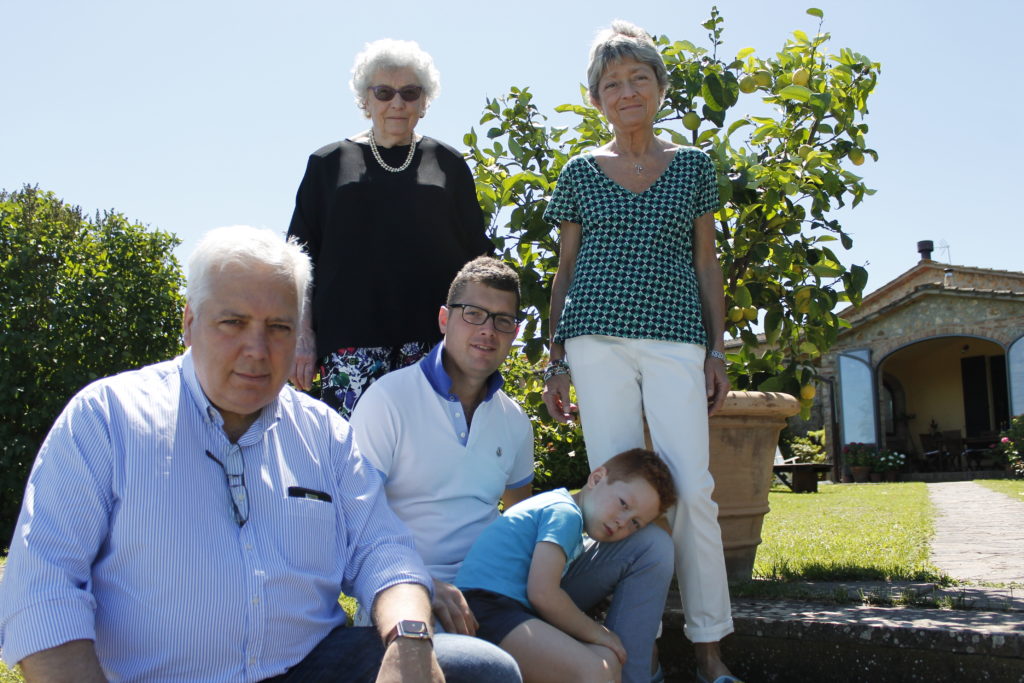
Today, Poggio Salvi is run by Mrs. Laura Bicchi, assisted in the commercial part by her husband Roberto Bonucci, while her son Jacopo Bonucci, winemaker and owner of the Poggio Salvi Ss farm in Sovicille deals with wine production. Jacopo Bonucci is also their agricultural expert in oenology.
The Poggio Salvi Sas avails itself for all that concerns the operations of packaging, preparation of orders and shipments, of the winery of the Azienda Agricola Poggio Salvi in Sovicille. The production of most of the Poggio Salvi wines takes place at the Poggio Salvi farm, the family’s historical heritage, located in the heart of Tuscany about 11 kilometres south-west of Siena, in the Municipality of Sovicille in the province of Siena, on the slopes of a gentle hill 280 meters high. Other wines are produced in Montepulciano and in Manciano in Maremma, in the Province of Grosseto.
Poggio Salvi has joined Asia Import Challenge 2019 and 5 of their wines won. Here are the wines that won the competition:
Campo del Bosco IGT Toscana – awarded Gold Medal by Asia Import News
Type: Red still
Year: 2007
Alcoholic grade: 13.5 °
Format: 0,750 l
Region / Area: Tuscany, Sovicille
The Grapes: 100% Sangiovese Grosso (Brunello)
The Soil: medium clay, rich in iron recognizable by the typical red color of the earth, mixed with large tufa areas and with fossil and coal residues.
Location of the vineyards: Poggio Salvi in the Municipality of Sovicille, on a slope facing south / south-west which slopes from 300 to 250 meters above sea level
Production Notes: the type of cultivation is the “spurred cordon”, with a plant layout of 2.5 x 0.70 m. and with a maximum production of grapes per hectare of 6000 Kg
Harvest: The manual harvest is carried out in the first half of October, with the selection of the best bunches of the vineyard, about one third of which are destined to withering.
Vinification: soft pressing of the grapes followed by fermentation at a controlled temperature of around 28-30 ° C. The days of maceration on the skins are long enough to allow a good extraction of color and matter. After a first drawing off the “government” is added (withered bunches specially chosen) to give color, roundness and structure. Then follows a further fermentation with permanence on the “government” until the beginning of spring when the wine is drawn off.
Aging: the wine is aged in oak barrels and tonneaux imported directly from France where it remains for about 12/14; completes bottle aging for a period of six months before being marketed.
The Eye: intense ruby red color, which fades slightly with aging
The nose: The aroma is intense with hints of wild berries, bread crust and vanilla.
The mouth: it is a structured wine with a soft and velvety taste that over the years reaches the peak of its “expressive power”
Eating: goes perfectly with meat dishes, game, parmesan cheese or aged pecorino.
To serve: at 18 ° C. For a perfect tasting, it is advisable to uncork and drain the bottle a little at least 1 hour before serving the wine, or oxygenate it in a special decanter.
Vino Nobile di Montepulciano DOCG – awarded Gold Medal by Asia Import News
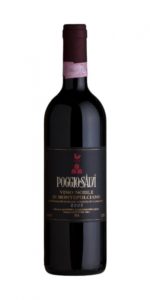 Type: Red still
Type: Red still
Year: 2010
Alcoholic grade: 13.5 °
Format: 0,750 l
Region / Area: Toscana, Acquaviva di Montepulciano
The Grapes: 90% Prugnolo Gentile, 5% Mammolo, 5% Canaiolo
The Soil: medium loam texture mixed with large tufaceous areas, basically thin, with sporadic outcrops of sand.
Location of the vineyards: the vineyards are located in Nottola, Argiano and Metina, areas considered among the most suitable for the production of Vino Nobile. The exposures are optimal and the proximity of the Trasimeno lake guarantees mild winters and not too dry summers that allow the vines to have a regular vegetative cycle
Production Notes: the type of cultivation is the “spurred cordon”, with a plant layout of 2.5 x 0.70 m. and with a maximum production of grapes per hectare of 7000 kg, as per production regulations
Harvest: Manual harvesting takes place in the first half of October.
Vinification: it is traditional with soft crushing of the grapes followed by fermentation at a controlled temperature below 28 ° C in stainless steel tanks made on purpose to obtain delicate tannins and extraction color.
Aging: after fermentation the wine remains on the steel vats until spring and then it is placed in medium-sized oak barrels and barriques where it remains in aging for 24 months and over
The Eye: intense ruby red color with garnet reflections.
The nose: it has a very delicate but spicy aroma, with light hints of violet
The mouth: excellent structure, fleshy, harmonious, sapid, with soft tannins
Eating: top class wine that goes perfectly with red meats, noble game and aged cheeses
To serve: at 18 ° C. For a perfect tasting, it is advisable to uncork and drain the bottle a little at least 1 hour before serving the wine, or oxygenate it in a special decanter
Chianti Colli Senesi DOCG – awarded Gold Medal by Asia Import News
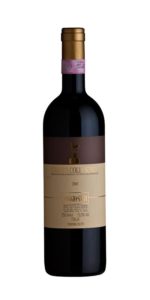 Type: Red still
Type: Red still
Year: 2012
Alcoholic grade: 13 °
Format: 0,750 l
Region / Area: Toscana, Sovicille (SI)
The Grapes: 90% Sangiovese, 5% Colorino, 5% Merlot
The soil : medium clay, rich in iron recognizable by the typical red color of the earth, mixed with large tufa areas and with fossil and coal residues
Location of the vineyards: Poggio Salvi in the Municipality of Sovicille, on a slope facing south / south-west which slopes from 300 to 250 meters above sea level
Production Notes: the type of cultivation is the “spurred cordon”, with a plant layout of 2.5 x 0.70 m. and with a maximum production of grapes per hectare of 7000 Kg
Harvest: Manual harvesting takes place at the end of September
Vinification: it is traditional with soft crushing of the grapes followed by fermentation at a controlled temperature below 28 ° C in stainless steel tanks made on purpose to obtain delicate tannins and extraction color.
Aging: after fermentation the wine remains on the steel vats until spring and is then placed in 30hl Slavonian oak barrels and barriques where it remains in aging for about 12 months
The Eye: intense ruby red color
The nose: slight hints of violets and withered flowers
The mouth: excellent structure, harmonious, sapid, with soft tannins
Eating: it goes perfectly with the typical dishes of Tuscan cuisine based on meat and aged cheeses
To serve: at 18 ° C.
Vin Santo del Chianti DOC – awarded Gold Medal by Asia Import News
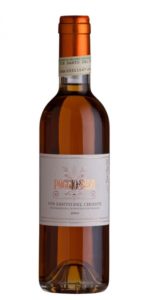
Type: White Passito
Year: 2003
Alcoholic grade: 16.5% Vol.
125 g / l sugar
Format: 0.375 l
Region / Area: Toscana, Sovicille (SI)
The Grapes: 60% Trebbiano, 40% Malvasia del Chianti
The soil : medium clay, rich in iron recognizable by the typical red color of the earth, mixed with large tufa areas and with fossil and coal residues
Location of the vineyards: Poggio Salvi in the Municipality of Sovicille, on a slope facing south / south-west which slopes from 300 to 250 meters above sea level
Production Notes: the type of cultivation is the “guyot”, with planting layout 2.5 x 0.70 m. and with a maximum production of grapes per hectare of 7000 Kg
Harvest: Harvesting is manual and carried out at the end of the harvest, usually around mid-October. The grapes are carefully selected by choosing the most sparse and healthy bunches that are hung from hooks attached to each other to the ceiling, in well-ventilated rooms, for drying.
Vinification: after a couple of months of drying the grapes are pressed and the must, dense and very sweet, is put into the 225-liter oak “barrels” placed under the cellar roof
Aging: Vin Santo remains in the “caratelli” for about 4 years undergoing all temperature changes (hot / cold) as the Tuscan tradition dictates. During this long period the vin santo ferments several times and slowly oxidizes, becoming a golden yellow color and acquires the aroma of the yeasts that have settled on the bottom of the keg over the years (the mother). Finishing in glass demijohns for a few months and then in the bottle ends
The Eye: bright golden color
The nose: intense and complex aromas of almond and orange due to long aging
The mouth: of excellent structure, velvety, harmonious, moderately sweet
Eating: vin santo is a sweet dessert wine that goes well with typical desserts of Tuscany (cantuccini) and cheeses with a strong flavor like gorgonzola.
To serve: at 8/10 ° C.
Vermentino “Refola” I.G.T di Maremma – awarded Silver Medal by Asia Import News
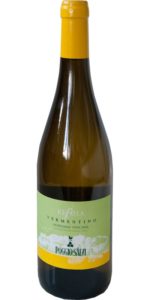 Type: Bianco fermo
Type: Bianco fermo
Year: 2013
Alcohol Content: 13°
Format: 0,750 l
Region/Area: Maremma Toscana, Manciano (GR)
Grapes: 100% Vermentino
The soil: sandstones rich with rock decomposition
Location of the vineyards: Manciano, on a slope facing south/south-west, which gradually descends from 200 to 100 metres above sea level
Production notes: the type of cultivation is the Guyot with 5.500 planting densit each hectar
Harvesting: mechanically during the second week of September
Wine-making: it is traditional, with the soft pressing of the grapes, followed by fermentation at controlled temperature, below 18° C, in stainless steel vats
Aging: after fermentation, which lasts an average of 15 days, the wine remains on the lees in stainless steel tanks until the month of February following the harvest, when it is bottled
At the eye: pale straw yellow
At the nose: aromas of yellow flowers and hints of succulent summer fruit, pulp and mature style fresh and fragrant
At the mouth: excellent body, harmonious, savoury, rightly acid
At the table: it is ideal to accompany shellfish, grilled fish, but it is also excellent as an aperitif
To serve: at 12° C.
If you want to see more of their wines, you can visit their website by CLICKING HERE!



